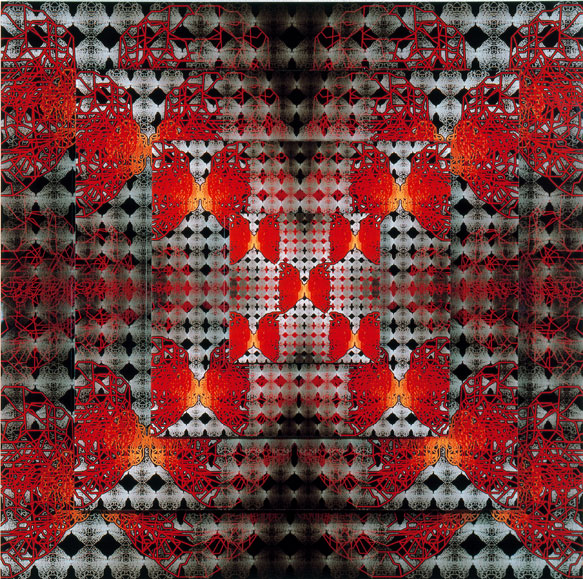LA COMPLEXITÉ DU REGARD

Dans l’œuvre de Jean-Claude Meynard, toute tentative de construction morphographique dépend de la volonté du regard qui peut y découvrir des formes humaines virtuelles. La discontinuité “moléculaire” des pièces du puzzle tend toujours à briser l’appréhension visuelle globale de la figure, à la dissoudre en une multitude de fragments autonomes.
Le concept d’auto-similarité à toute échelle d’observation s’y affirme avec force au service d’une prise de conscience contradictoire. Celle-ci relève de l’esprit dialogique, de l’omniprésence de l’ordre géométrique d’une part, et d’autre part, de la chaotisation plastique engendrée par les multiples chemins labyrinthiques qui parcourent l’œuvre en tout sens. Les espaces morcelés de la peinture fractale de Jean-Claude Meynard induisent à la fois une forme de déréalisation du sujet percevant, incapable de s’imposer vraiment en tant que moteur de projection univoque du sens, autant qu’une “virtualisation” indéfinie du “sujet” global instable, précaire, constitutif du contenu figuratif possible de la représentation. La prolifération fragmentaire néantise toute conscience de totalité, mais celle-ci s’affirme par réaction, comme une exigence idéale d’autant plus vive de synthèse perceptive et de quête du sens.
Jean-Claude Chirollet - 1999
Extrait de La Complexité du Regard - “ Art fractaliste ”
Ed. 00h00.com, Paris

Beyond simply making a statement, it is possible to provide an epistemological basis for the fractal concept.
And even if it seems a bit of a detour, I propose to shed some light on it by showing the role of the third term, that is, the plural, in any structured form whatsoever.
The number “3” is to be construed symbolically, of course, as that which opens up onto infinity and its ordering.
Like in chemistry, it can be said that everything is the result of combinations: through the differentiated association of elements, one obtains one specific body or another, but from a tiny change or according to how one element is moved, the whole can change shape. In the end, this is how the passage from one equilibrium to another is effected. It is within such combinatorial mathematics that the role of the third term can be appreciated: the figure “3” is understood as a metaphor for the fractal, a component of a worldly given. Historical, theoretical and anecdotal references constitute a mass of illustrations before us all showing how taking the plural into account always corresponds to a point in time when something new is founded, a cultural moment.

In Jean-Claude Meynard’s work, every attempt at morphographic construction depends on the viewer’s will to discover in it virtual human forms. The “molecular” discontinuity of puzzle pieces always tends to shatter the global visual apprehension of the figure, dissolving it into a multitude of autonomous fragments.
The concept of self-similarity at every level of observation is therein affirmed forcefully in favor of a contradictory awareness. On one hand, this comes from the dialogical spirit, the omnipresence of the geometrical order, and on the other, from the plastic chaoticization engendered by the multiple labyrinthic paths that traverse the work in all different directions. The broken up spaces in
Jean-Claude Meynard’s fractal painting infer both a form of derealization of the perceiving subject, incapable of truly imposing himself as the univocal engine of meaning, and an indefinite “virtualization” of the global “subject” which remains unstable and precarious as it constitutes the possible figurative content of the representation. Fragmentary proliferation annihilates all consciousness of totality, but affirms itself as a reaction, like an ideal necessity even more alive with perceptive synthesis and the quest for meaning.